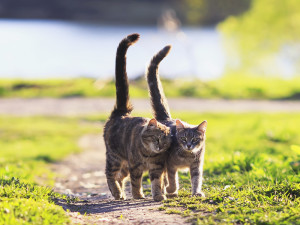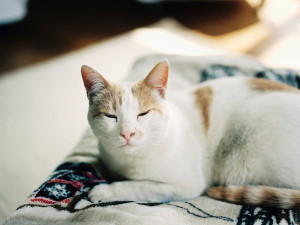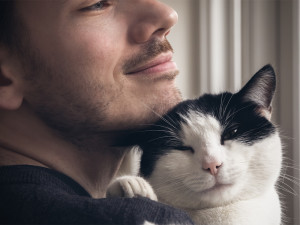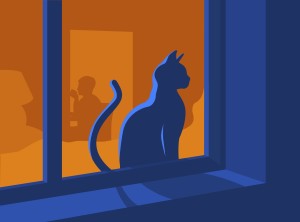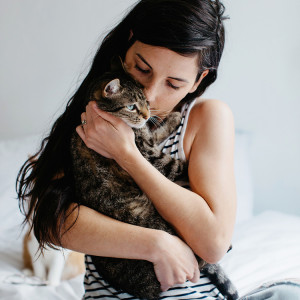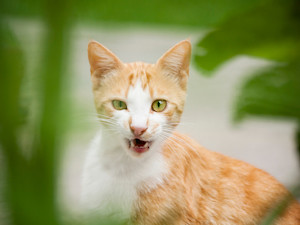Why Do Cats Slow Blink?
Here’s what your cat’s favorite move means.
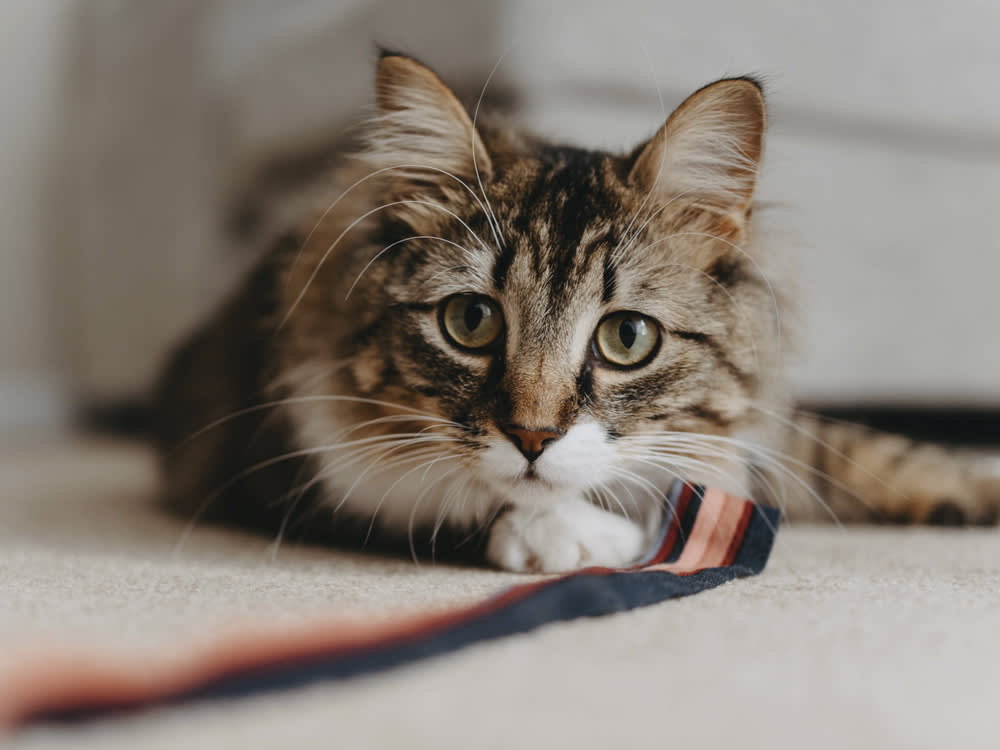
share article
Cats communicate in lots of different ways. They meow opens in a new tabto get our attention and purr to let us know we’re scratching them in just the right spot. They swish their tailsopens in a new tab around when they are annoyed and sometimes, when things are quiet and they’re feeling truly safe and content, they give us what’s called the “slow blink.”
Slow blinking is a gesture of trust and affection that cats use to communicate with each other. When a cat slow blinks at you, it’s a sign that they feel comfortable and safe around you. You can use slow blinking to communicate with your cat and build a stronger bond with them. With a little practice, you will be able to use slow blinking to communicate with your cat and connect with them more deeply.
What does it look like when a cat slow blinks?
The slow blink, for those who don’t know, is just what it sounds like: a leisurely closing and opening of the eyes that, to the uninitiated, probably looks like any other blink. But it’s not like any other blink. With a slow blink, your cat will completely or partially shut their eyelids for more than half a second.
What does the cat slow blink mean?
“The slow blink is a sign of trust,” says certified feline behavior consultant and The Wildest Expert Collective member Cristin Tamburoopens in a new tab. “Your cat is showing that they are relaxed and comfortable in your presence.” Does that mean they love you? It’s probably better to think of the slow blink like the feline version of a gentle, welcoming smile.
What are the benefits of slow blinking with your cat?
The main benefit of slow blinking with your cat is that it lets them know they can trust you. “When I’m working with fearful cats or cats who do not know me, I always use the slow blink method to try and signify to them that I am not a threat,” Tamburo says. “Quite often, they will slow blink back, almost as if they truly understand. You will notice that many cats, when fearful or aggressive, have big, staring eyes, so the soft, slow blinks essentially let them know you are not there to harm them.”
How to slow blink back
When I slow blink at my own catopens in a new tab, Pumpkin, he takes it as an invitation and promptly trots over for a kiss and a snuggleopens in a new tab. Indeed, he usually only slow blinks back at me when he’s in my arms and we are already as close as physically possible. “It’s a great way of enhancing the bond you have with cats,” says Professor Karen McComb, PhD, who studies animal behavior at the University of Sussex. “It is something you can try yourself with your own cat at home, or with cats you meet in the street. Try narrowing your eyes at them as you would in a relaxed smile, followed by closing your eyes for a couple of seconds. You’ll find they respond in the same way themselves and you can start a sort of conversation.”
Indeed, according to a recent studyopens in a new tab by Dr. McComb and Dr. Tamsin Humphrey, cats are more likely to slow blink at their parents if their parents slow blink at them first. They are also more likely to slow blink at slow blinking strangers than those who just stare at them neutrally, and were generally much more likely to approach people who slow blinked at them first, whether they knew them or not.
As for how cats developed the slow blink, Dr. Humphrey suspects that, like many feline behaviors, it arose out of their interactions with humans. “It could be argued that cats developed the slow blink behaviors because humans perceived slow blinking as positive,” Dr. Humphrey says. “Cats may have learned that humans reward them for responding to slow blinking. It is also possible that slow blinking in cats began as a way to interrupt an unbroken stare, which is potentially threatening in social interaction.”
Do cats slow blink at one another?
Yes, it’s common to see cats slow blink at one another. When you see one cat slow blinking at another cat, it means they are communicating that they are friendly and not threatening to the other cat. On the other hand, a hard stare between cats is usually perceived as a threat or a challenge.
What does it mean when a cat stares with dilated pupils?
“There are lots of ways that cats communicate with their eyes,” Tamburo says. “Slit/squinty eyelids can be a sign of fear or aggression. Dilated pupils and staring can indicateopens in a new tab a cat is aroused — asserting their dominance or about to become aggressive — and pupils that are small slits can be signs of pleasure, excitement, fear, or anger. Eye language can mean different things, so it’s always important to assess the whole cat — eyes, ears, whiskers, body, and tail postureopens in a new tab to get a better understanding of what they are truly trying to tell us.”
But, in general, if you’re on the receiving end of a slow blink, it means that you are doing something right — your cat is happy and chill and right where they want to be, and that’s really all you need to know.
FAQs (People also ask):
Can slow blinking help calm an anxious cat?
Yes, slow blinking can help calm an anxious catopens in a new tab. If you slow blink at a cat, it lets them know that you are not a threat and they do not need to be afraid.
Is slow blinking the same as a cat’s normal blinking?
No, slow blinking is not the same as normal blinking. A slow blink last more than half a second, which is longer than a regular cat blink.
Can slow blinking replace other forms of communication with cats?
No, slow blinking cannot replace other forms of communication with cats. Slow blinking is just one way to let a cat know that they can trust you.
References:

Charles Manning
Charles Manning is an actor, writer, and fashion/media consultant living in New York City with his two cats, Pumpkin and Bear. Follow him on Instagram @charlesemanningopens in a new tab.
Related articles
![cat snuggling man]() opens in a new tab
opens in a new tabWhat’s Your Cat’s Love Language?
Five surprising ways cats show affection (and how you can show it back), according to a cat behaviorist.
![A woman with curly black hair sitting in front of a dark purple and yellow backdrop while looking down affectionately at her two cats sitting on her lap]() opens in a new tab
opens in a new tabHow to Build Your New Cat’s Trust in You
If your cat still approaches you with a figurative arched eyebrow of skepticism, try these tricks to put them at ease.
![]() opens in a new tab
opens in a new tabThis Study Says You Literally Can’t Hide From Your Cat
Happy spooky season.
![dark-haired woman hugging cat that has imprinted on her]() opens in a new tab
opens in a new tab10 Signs Your Cat Has Imprinted on You
Feeling like you have a little shadow these days? Here’s why that’s happening.
![A cat outside showing its bottom teeth.]() opens in a new tab
opens in a new tabWhat’s All the Cat Chatter About?
Scientists believe they could be mimicking the calls of their prey.
